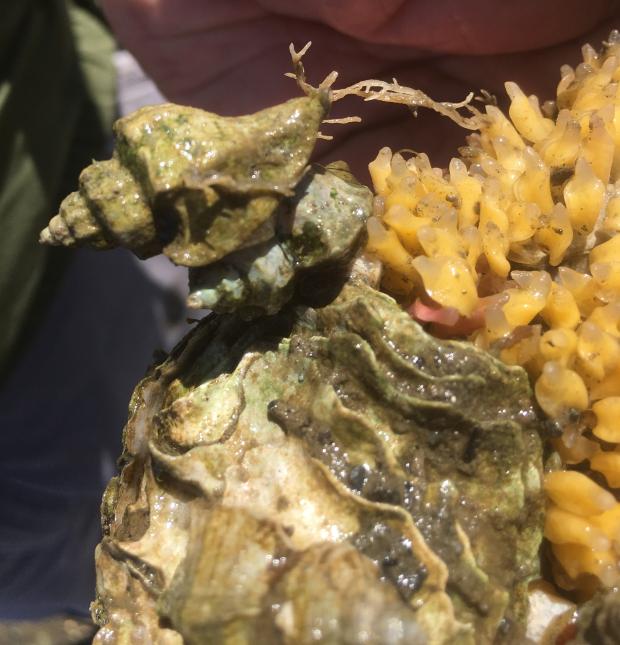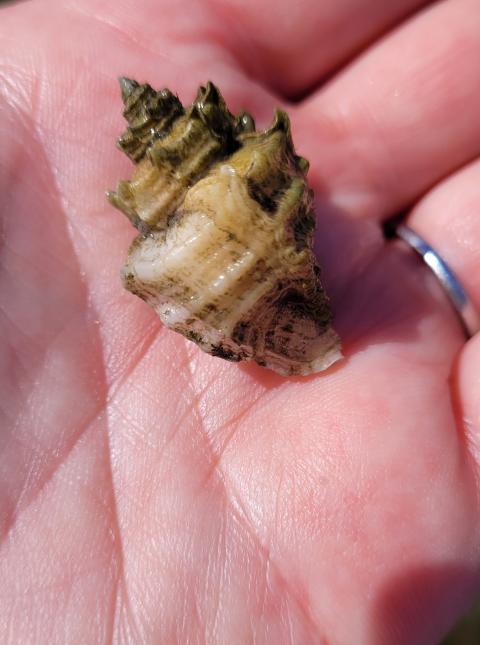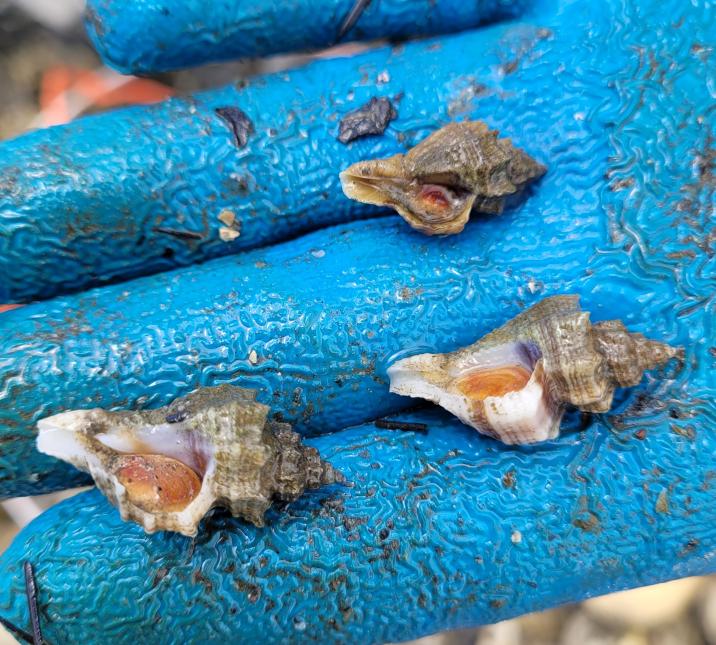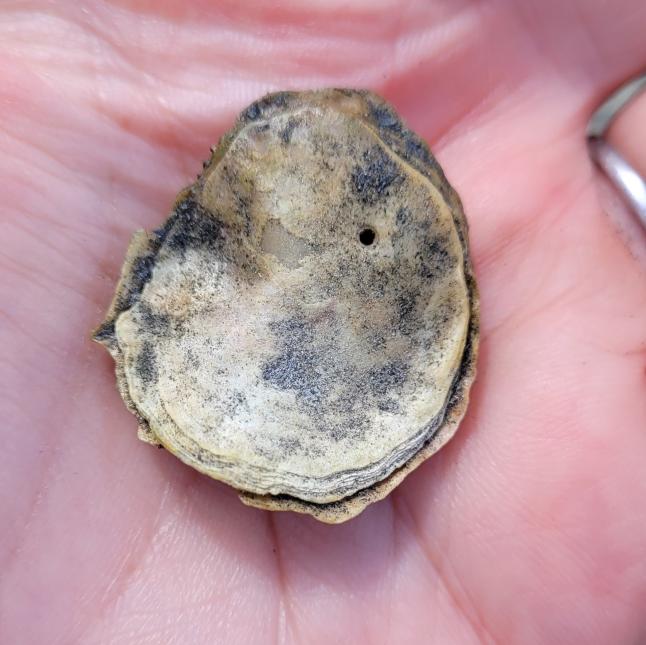For a map of Japanese oyster drill restricted areas, please visit this webpage. For more information on shellfish transfers, please visit this webpage.
Download our Japanese oyster drill identification card here (PDF).
Japanese oyster drills (Ocinebrellus inornatus) are a predatory snail native to eastern Asia and accidentally introduced to Puget Sound in 1924 as hitchhikers with Pacific oysters and oyster shell imported for aquaculture; it made its way to Willapa Bay by 1965. They are one of two non-native predatory oyster drills in Washington (the other is the Eastern oyster drill, Urosalpinx cinerea) and are so-named for their feeding strategy that involves penetrating the shell of prey by "drilling" a hole and then secreting digestive enzymes into the body of the prey. Drills feed on a range of shellfish, such as Pacific oysters (Magallana gigas), Manila clams (Venerupis phillipinarum), Olympia oysters (Ostrea lurida), mussels (Mytilus spp.), and barnacles. They are especially fond of juvenile or "spat" oysters and have become a nuisance for shellfish growers, Olympia oyster restoration, and native marine ecosystems. They may be a major factor limiting Olympia oyster recovery locally.
Description and Range
Physical description
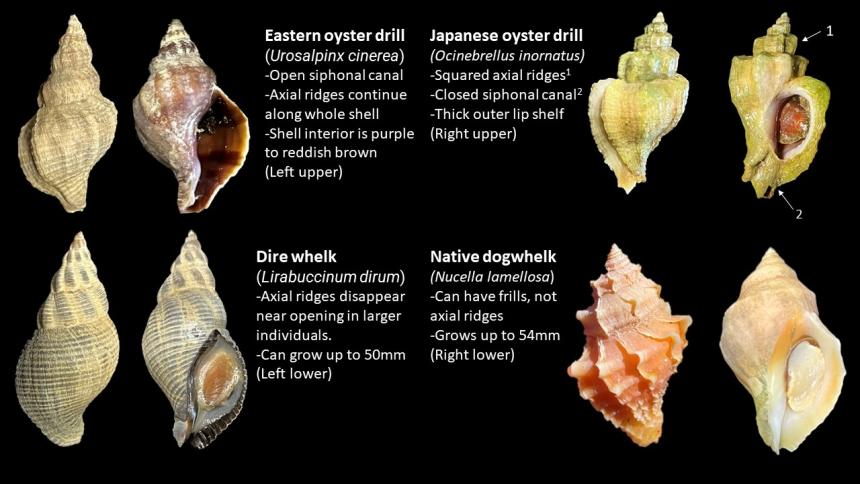
The Japanese oyster drill is a marine snail with a heavy shell featuring an ornate design. The shell can be brown, green, orange, beige, or striped and can reach about 50mm in length (1.9 inches); it is generally closer to 40mm (1.5 inches) in length.
This species can be confused with native species of drilling predatory snails, such as the native dogwhelk (Nucella lamellosa) to which it (and its egg casings) bear some resemblance. Native dogwhelks primarily eat barnacles and are not considered pests of aquaculture or native ecosystems, contrasting with the preferred diet and status of the non-native Japanese oyster drill. Native whelks have a heavier, chunkier shell and are generally larger (commonly up to 54mm or 2.1 inches but reportedly reaching 100mm, or almost 4 inches). They come in smooth-shelled, smooth-banded, and frilly shelled variations. Their egg casings lack the twist and vase-shape of non-native drills, instead resembling a smooth, torpedo-like shape. A good description of native Nucella lamellosa can be found here, courtesy of the Oregon Institute of Marine Biology.
Ecology and life history
Drills are found in the intertidal zone in various locations in Puget Sound, Hood Canal, the Strait of Juan de Fuca, and Willapa Bay. They prefer hard substrate, especially structure provided by Pacific oyster shells, clusters, and beds/reefs (where they feed, shelter, and lay their eggs)--but can also be found on or around manmade structures like cinderblocks, aquaculture gear, and debris. They can also be found (often in lower densities) in soft substrates.
They use secretion of an acid and a raspy tongue-like structure called a radula to puncture or "drill" holes through their prey's shell, then using secretion of a digestive enzyme into the body of their prey to enable them to feed. Drills feed on a range of shellfish, such as Pacific oysters (Magallana gigas), Manila clams (Venerupis phillipinarum), Olympia oysters (Ostrea lurida), mussels (Mytilus spp.), and barnacles. They are especially fond of small juvenile or "spat" oysters. Larger shellfish, with thicker shells, are less vulnerable to drill predation.
Drills gather and lay benthic rice-grain-sized egg capsules on hard structures in Spring. Egg capsules are laid in clusters and can be orange, yellow, and pink in color. They can be discerned from native whelk egg capsules by their pronounced twisted "vase-like" shape. Hatching juveniles are miniature versions of adults and emerge as "crawl away" juveniles with no pelagic (waterborne drifting/swimming) larval stage--which limits their dispersal ability. Because of this strategy, human-aided dispersal (such as moving shellfish, equipment, or debris with hitchhiking drills) is the chief pathway for further spread in Washington.
Geographic range
The species is native to the northwest Pacific Ocean (Japan, northern China, South Korea) and has since been introduced to the Pacific coast of North America from British Columbia to Oregon and parts of California, as well as to several European countries. It is found in high densities in some locations in Puget Sound, Hood Canal, the Strait of Juan de Fuca, and Willapa Bay. Its distribution in Washington is still patchy (localized) as the species has limited natural dispersal ability, and WDFW is working to keep it from being introduced to new areas of our shoreline.
Regulations
Rules and seasons
Japanese oyster drills are non-native pests and WDFW has measures in place to limit their spread from established areas. The movement of shellfish, equipment, vessels, debris, and other items that spend time on marine shorelines occupied by oyster drills can lead to their introduction to areas previously free of them.
Permits: Transfer permits from the Washington Department of Fish and Wildlife are required for the transfer of shellfish, shellfish aquaculture products (including oyster seed, cultch and shell), aquaculture equipment (including aquaculture vehicles and vessels) or any marine organisms adversely affecting shellfish. Learn more on our webpage: Shellfish, aquatic invertebrate, and seaweed health and cultivation permitting information.
Restricted Areas: WDFW designates areas infested by oyster drills as Restricted Areas, and movement of shellfish and equipment from these areas to areas considered Unrestricted (free of oyster drills) or Undesignated is prohibited or restricted with conditions intended to minimize risk. A map is available on this page, and more information on Oyster Drill Restricted Areas can be found here (RCW 77.12.455; 77.60.060; WAC 220-340-130; WAC 220-340-140). WDFW conducts surveys to monitor the distribution of oyster drills and inspects facilities to ensure risk of transfer from one area to another is minimized.
Oyster drills are classified as Unclassified Marine Invertebrates and cannot be legally harvested without a Scientific Collection Permit permit (WAC 220-311-040).
